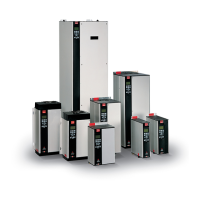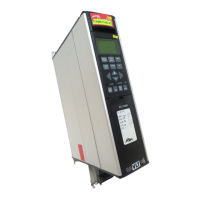4-4
VLT is a registered Danfoss trademark
INTERNAL DRIVE PROBLEMS
The vast majority of problems related to failed drive power
components can be identified by performing a visual inspection
and the static tests as described in the test section. There
are, however, a number of possible problems that must be
diagnosed in a different manner. The following discusses many
of the most common of these problems.
Overtemperature Faults
In the event that an overtemperature indication is displayed,
determine whether this condition actually exists within the drive
or whether the thermal sensor is defective. Of course, this
can easily be detected by feeling the outside of the unit, if the
overtemperature condition is still present. If not, the temperature
sensor must be checked. This can be done with the use of an
ohmmeter in accordance with the thermal sensor test
procedure.
Current Sensor Faults
When a current sensor fails, it is indicated sometimes by an
overcurrent alarm that cannot be reset, even with the motor
leads disconnected. Most often, however, the drive will
experience frequent false earth fault trips. This is due to the
DC offset failure mode of the sensors.
To explain this it is necessary to investigate the internal makeup
of a Hall effect type current sensor. Included inside the device
is an op-amp to amplify the signal to usable levels in the
receiving circuitry. Like any op-amp, the output at zero input
level (zero current flow being measured) should be zero volts,
exactly half way between the plus and minus power supply
voltages. A tolerance of +/- 15mv is acceptable. In a three
phase system that is operating correctly, the sum of the three
output currents should always be zero.
When the sensor becomes defective, the output voltage level
varies by more than the 15mv allowed. The defective current
sensor in that phase indicates current flow when there is none.
This results in the sum of the three output currents being a
value other than zero, an indication of leakage current flowing.
If the deviation from zero (current amplitude) approaches a
specific level, the drive assumes an earth fault and issues an
alarm.
The simplest method of determining whether a current sensor
is defective is to disconnect the motor from the drive, then
observe the current in the display of the drive. With the motor
disconnected, the current should, of course, be zero. A drive
with a defective current sensor will indicate some current flow.
Because the current sensors for the higher horsepower drives
have less resolution, an indication of a fraction of an amp on a
drive is tolerable. However, that value should be considerably
less than one amp. Therefore, if the display shows more than
one amp of current, there is a defective current sensor.
To determine which current sensor is defective, measure the
voltage offset at zero current of each current sensor. See the
current sensor test procedure (5.2.12).
